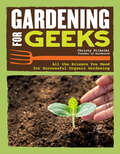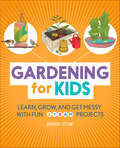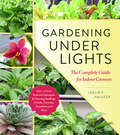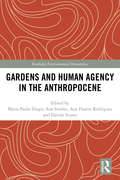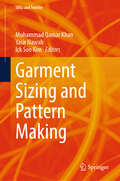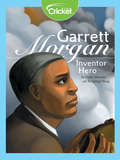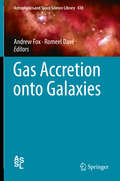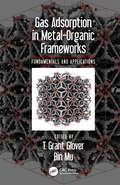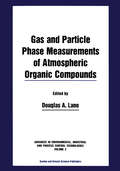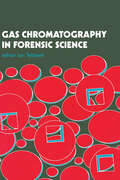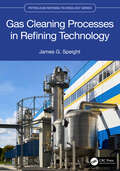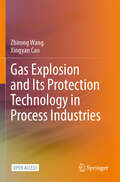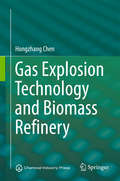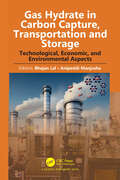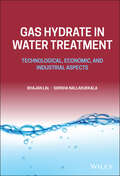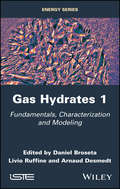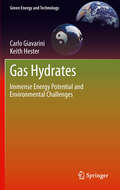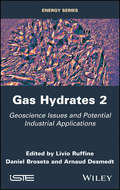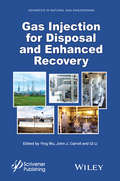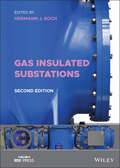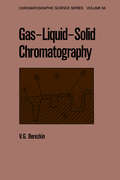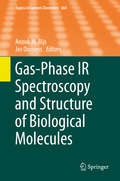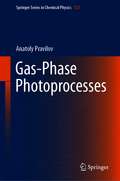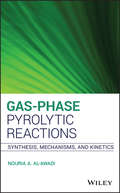- Table View
- List View
Gardening for Geeks: All the Science You Need for Successful Organic Gardening
by Christy WilhelmiThe founder of Gardenerd.com presents ultimate guide to organic gardening for geeks who want to know the science behind flourishing flora. In Gardening for Geeks, Christy Wilhelmi breaks down the biology and ecology of gardening in an engaging and accessible way. She explains how plants work, how soil lives, how bugs help, and much more. Plus she offers practical advice on everything from planning to pest control. Filled with more than one hundred fifty photos, step-by-step processes, helpful diagrams and illustrations, and expert tips, this beginner's guide covers all the gardening basics, whether you're planting in the country or in an urban area. Christy then introduces more advanced concepts, strategies, and techniques to help you get the most out of your garden. This edition also includes plant profiles, the latest research and terminology, and more photographs and illustrations.
Gardening for Kids: Learn, Grow, and Get Messy with Fun STEAM Projects
by Brandy StoneSharpen STEAM skills—and have a blast—with educational gardening projects for kids 8 to 12Discover how fun and educational growing plants can be. Gardening for Kids is packed with essential information for beginner gardeners and tons of awesome projects that help kids grow their science, technology, engineering, art, and math (STEAM) skills.Go outside with easy-to-try experiments that will teach you all about the environment, plants, and what it takes to grow and maintain your very own garden. Find out what your soil is made of, make a miniature greenhouse, race seeds, and so much more!Gardening for Kids provides:Gardening 101—Learn everything you need to get your garden started today, from basic safety tips to helpful advice on caring for your plants.25 Gardening projects—Dig into the natural world with a ton of fun experiments like sprouting food scraps, building plant forts, and more—each one focusing on specific STEAM skills.A chance to grow together—This book features handy tips for expanding projects to work with groups of kids so you can share the fun in classrooms and community gardens.Grow a love of science, technology, engineering, art, and math—plus lots of plants—with Gardening for Kids.
Gardening Under Lights: The Complete Guide for Indoor Growers
by Leslie F. Halleck“If you want to grow plants indoors, you need this book.” —Niki Jabbour, author and staff writer at savvygardening.comGardening Under Lights is a highly-detailed, accessible guide for seed starters, plant collectors, houseplant fans, and anyone who wants to successfully garden indoors any time of the year. You’ll learn the basics of photosynthesis, the science of light, how to accurately measure how much light a plant needs, and details about the most up-to-date tools and gear available. Also included are tips and techniques for helping ornamental plants (like orchids, succulents, bonsai, and more) and edible plants (arugula, cannabis, oregano, tomatoes, and more) thrive indoors. Whether you are a vegetable gardener who wants to extend the growing season, a balcony gardener short on outdoor space, or a specialty plant collector, Gardening Under Lights is a must-have.
Gardens and Human Agency in the Anthropocene (Routledge Environmental Humanities)
by Maria Paula Diogo Ana Duarte Rodrigues Ana Simões Davide ScarsoThis volume discusses gardens as designed landscapes of mediation between nature and culture, embodying different levels of human control over wilderness, defining specific rules for this confrontation and staging different forms of human dominance. The contributing authors focus on ways of rethinking the garden and its role in contemporary society, using it as a crossover platform between nature, science and technology. Drawing upon their diverse fields of research, including History of Science and Technology, Environmental Studies, Gardens and Landscape Studies, Urban Studies, and Visual and Artistic Studies, the authors unveil various entanglements woven in the past between nature and culture, and probe the potential of alternative epistemologies to escape the predicament of fatalistic dystopias that often revolve around the Anthropocene debate. This book will be of great interest to those studying environmental and landscape history, the history of science and technology, historical geography, and the environmental humanities.
Garment Sizing and Pattern Making (SDGs and Textiles)
by Muhammad Qamar Khan Yasir Nawab Ick Soo KimThis book investigates the best possibilities of garments constructions through proper pattern techniques which can enhance the efficiency of organization and minimize the wastage of materials within sustainable developments. It also enhances the importance of sizing system for brands & suppliers for development of garment fit, garment comfort and durable garments. It also covers the many practical areas, such as education and skill development, improved garment quality, standardization and consistency, innovation and customization, reducing wastage, cost savings, improved fit and customer satisfaction, cross-disciplinary applications, accessibility and global impact, industry advancements, etc. In conclusion, this is a comprehensive book on garment sizing and pattern making, which has a substantial impact on the fashion and clothing industry, from education and skill development to improved product quality, standardization, and sustainability. It plays a vital rolein shaping the future of fashion design and production and empowers the designers for the best entrepreneur.
The Garnaut Review 2011
by Ross GarnautIn this update to the 2008 Garnaut Climate Change Review, Ross Garnaut re-examines the case for action in the aftermath of the global financial crisis and recent developments by major countries to reduce emissions and prepare for a low-carbon future. He guides the reader through the climate change debate, and explains why Australia's contribution is vital to the national interest and matters to the global effort. He outlines a set of policies through which Australia can contribute its fair share without damaging Australian prosperity. The Garnaut Review 2011: Australia in the Global Response to Climate Change extends the analysis to contemporary economic, political and environmental conditions in a way that is clear and easy to understand. It is an essential resource for all who care about the future of our economy and environment.
Garrett Morgan: Inventor Hero
by Paula MorrowGarrett Morgan was an inventor concerned for the well-being of other people. His inventions included the safety hood gas mask and signals that set the standard for today's traffic lights. It is easy to see that the lives of many people were made better or saved by Garrett Morgan’s inventions.
Gas Accretion onto Galaxies
by Andrew Fox Romeel DavéThis edited volume presents the current state of gas accretion studies from both observational and theoretical perspectives, and charts our progress towards answering the fundamental yet elusive question of how galaxies get their gas. Understanding how galaxies form and evolve has been a central focus in astronomy for over a century. These studies have accelerated in the new millennium, driven by two key advances: the establishment of a firm concordance cosmological model that provides the backbone on which galaxies form and grow, and the recognition that galaxies grow not in isolation but within a "cosmic ecosystem" that includes the vast reservoir of gas filling intergalactic space. This latter aspect in which galaxies continually exchange matter with the intergalactic medium via inflows and outflows has been dubbed the "baryon cycle". The topic of this book is directly related to the baryon cycle, in particular its least well constrained aspect, namely gas accretion. Accretion is a rare area of astrophysics in which the basic theoretical predictions are established, but the observations have been as yet unable to verify the expectations. Accretion has long been seen around the Milky Way in so-called High Velocity Clouds, but detecting accretion even around nearby galaxies has proved challenging; its multi-phase nature requires sensitive observations across the electromagnetic spectrum for full characterization. A promising approach involves looking for kinematic signatures, but accretion signatures are often confused with internal motions within galaxies. Accretion studies therefore touch a wide range of astrophysical processes, and hence a wide cross-section of the astronomical community. As observational facilities are finally able to access the wavelength ranges and depths at which accretion processes may be manifest, the time is right to survey these multiple lines of investigation and determine the state of the field in accretion studies of the baryon cycle.
Gas Adsorption in Metal-Organic Frameworks: Fundamentals and Applications
by T. Grant Glover and Bin MuThis text discusses the synthesis, characterization, and application of metal-organic frameworks (MOFs) for the purpose of adsorbing gases. It provides details on the fundamentals of thermodynamics, mass transfer, and diffusion that are commonly required when evaluating MOF materials for gas separation and storage applications and includes a discussion of molecular simulation tools needed to examine gas adsorption in MOFs. Additionally, the work presents techniques that can be used to characterize MOFs after gas adsorption has occurred and provides guidance on the water stability of these materials. Lastly, applications of MOFs are considered with a discussion of how to measure the gas storage capacity of MOFs, a discussion of how to screen MOFs to for filtration applications, and a discussion of the use of MOFs to perform industrial separations, such as olefin/paraffin separations. Throughout the work, fundamental information, such as a discussion on the calculation of MOF surface area and description of adsorption phenomena in packed-beds, is balanced with a discussion of the results from research literature.
Gas and Particle Phase Measurements of Atmospheric Organic Compounds
by Douglas A. LaneIt is becoming increasingly important to understand how and why semivolatile atmospheric pollutants partition between gas phase and particulate matter in the atmosphere. In this text the world's leading researchers in the field explain the significance of gas/particle ratios; physical and chemical parameters determining how semivolatiles partition in the atmosphere; how gas/particle ratio measurements are made; what artefacts occur during sampling; and novel new techniques and instruments for obtaining artefact-free results. Intended to be a reference book and a guide for those who study the gas/particle ratios of semivolatile atmospheric compounds. This book will be of interest to beginners in the field as well as those who have been involved in the field for many years and would like, in a single reference text, a comprehensive compendium of what is known about the theory and practice of gas/particle phase measurements.
Gas Chromatography In Forensic Science
by I. TebbettDescribes the application of gas chromatography to various aspects of forensic chemistry. Following an introduction to the basic theory of chromatographic separations, the text discusses specific issues, such as drug analysis, fires and explosives, alcohol and toxicology.
Gas Cleaning Processes in Refining Technology (Petroleum Refining Technology Series)
by James G. SpeightThis book focuses on the various refinery processes that are used for gas cleaning operations. By understanding the use of gas cleaning processes, this book will satisfy the needs of engineers and scientists at all levels from academia to the refinery and help them understand the initial various processes. This accessible guide is written for managers, professionals, and technicians as well as graduate students transitioning into the refining industry.Key Features: Describes gas streams produced in a crude oil refinery and from non-refinery feedstocks. Covers gas condensate, gas from biomass, waste and landfill waste, and details categorization by types of contaminants and by removal method. Provides an extensive glossary. Discusses the future of gas cleaning operations and the evolution of the industry. This series of eight books is designed to present descriptions of (1) the development of technologies for a variety of feedstocks (including the viscous feedstocks which are often referred to as heavy feedstocks) utilizing advanced pre-treatment processing and hydrotreating, (2) an analysis of the catalyst deactivation mechanism for developing optimum technologies for processing feedstocks with low reactivity, (3) the development of advanced technologies applicable to the viscous feedstocks, (4) the development of advanced hydrocracking processes for heavy feedstock upgrading, (5) the development of innovative upgrading processes for the viscous feedstocks, and (6) the role of biomass in the future refinery. Furthermore, each book is a stand-alone volume that will bring the reader further up to date and adds more data as well as processing options that may be the processes of the evolving twenty-first century. As the eighth book in the series, this book will focus on the various refinery processes that are used for gas cleaning operations.The target audience includes engineers, scientists, and students who want an update on crude oil processing and the direction of the industry in the next 50 years. Such personnel include (1) professionals in the refining industry, (2) technicians in the refining industry, (3) industry management personnel who need to understand the various processes and the role of these process in producing the desired feedstocks for further processing and the use of solvents to produce saleable products, and (4) the academic staff and graduate students who are moving into the refining industry. Any non-technical readers, with help from the extensive glossary, will also benefit from the series.
Gas Explosion and Its Protection Technology in Process Industries
by Zhirong Wang Xingyan CaoThis open access book first introduces the explosive characteristics of combustible gas in the process industrial device, and then introduces the influence law of structural effect on gas explosion characteristics and deflagration to detonation process, and finally introduces the suppression mechanism and protection technology of gas explosion. This book takes the process industrial gas explosion characteristics and its protection as the research object, and discusses the gas explosion characteristics and its protection theory in details. This book can be used as the undergraduate and graduate textbook of safety engineering and related engineering majors in universities, and also as a reference for scientific research staff in safety science and engineering and related disciplines, and also for the reference of safety technology and management personnels.
Gas Explosion Technology and Biomass Refinery
by Hongzhang ChenThe book introduces gas explosion technology (GET) and its applications in biomass refineries. In this book an overview of GET is provided, the mechanisms are thoroughly discussed. The chapters also cover the latest processes and equipments of GET, including equipment selection, parameter determination and engineering scaling-up. Last but not least the applications of GET are introduced in details. It is an excellent reference and guidance for scientists engaging in the research of biomass and biotechnology. Professor Hongzhang Chen is the Vice Director and Supervisor of the State Key Laboratory of Biochemical Engineering at the Institute of Process Engineering of the Chinese Academy of Sciences.
Gas Hydrate in Carbon Capture, Transportation and Storage: Technological, Economic, and Environmental Aspects
by Bhajan Lal Anipeddi ManjushaThis book offers a deep insight into gas hydrate-based carbon capture, transportation, and storage technology as a solution to decarbonization. The key aspects of carbon capture & storage technologies are discussed together with their advantages and status of development and commercialization. The authors delve into intricacies of gas hydrate reactor design, provide a review on the Techno-Economic Aspects (TEA), expound critical safety considerations and elucidate upon the regulatory mandates shaping the landscape of decarbonization initiatives.Gas Hydrate in Carbon Capture, Transportation and Storage: Technological, Economic, and Environmental Aspects is an essential resource for all academicians, researchers, flow assurance engineers, industry professionals and students working in this field.
Gas Hydrate in Water Treatment: Technological, Economic, and Industrial Aspects
by Bhajan Lal Sirisha NallakukkalaGAS HYDRATE IN WATER TREATMENT Explores current progress in the expanding field of gas hydrate-based desalination As potable water shortages continue to affect billions of people worldwide, seawater desalination and wastewater treatment have the potential to meet freshwater demands in the near future. Gas hydrate-based desalination, a process which requires CO2 and water as solvent, has become an increasingly popular approach—desalination with hydrates is environmentally friendly and can produce cheaper desalted water than other existing conventional technologies. Gas Hydrate in Water Treatment: Technological, Economic, and Industrial Aspects provides detailed, up-to-date reference to the application of gas hydrates in wastewater and seawater desalination treatment. Edited by experienced researchers in the field, this comprehensive volume describes the fundamental aspects of desalination and summarizes the latest research on gas hydrate-based desalination. The authors address a broad range of key topics, including issues related to water scarcity, post-treatment of desalinated water using both conventional and new technologies, hydrate-based desalination methods driven by renewable energy sources, and more. Provides thorough coverage of the technological, waste brine management, economic, and renewable energy and remineralization aspects of gas hydrate-based wastewater treatment Describes the energetic, economic, and environmental impact of gas hydrate desalination Explains the core concepts of gas hydrate-based desalination to help readers evaluate the performance of existing desalination processes Discusses the advantages and challenges of hydrate-based water treatment Compares conventional and gas hydrate technologies used in water treatment Reviews the most recent research in gas hydrate-based desalination Gas Hydrate in Water Treatment: Technological, Economic, and Industrial Aspects is an essential resource for all academics, researchers, process engineers, designers, industry professionals, and advanced students in the field.
Gas Hydrates: From Characterization and Modeling to Applications
by Daniel Broseta Desmedt Arnaud Livio RuffineGas hydrates, or clathrate hydrates, are crystalline solids resembling ice, in which small (guest) molecules, typically gases, are trapped inside cavities formed by hydrogen-bonded water (host) molecules. They form and remain stable under low temperatures – often well below ambient conditions – and high pressures ranging from a few bar to hundreds of bar, depending on the guest molecule. Their presence is ubiquitous on Earth, in deep-marine sediments and in permafrost regions, as well as in outer space, on planets or comets. In addition to water, they can be synthesized with organic species as host molecules, resulting in milder stability conditions: these are referred to as semi-clathrate hydrates. Clathrate and semi-clathrate hydrates are being considered for applications as diverse as gas storage and separation, cold storage and transport and water treatment. This book is the first of two edited volumes, with chapters on the experimental and modeling tools used for characterizing and predicting the unique molecular, thermodynamic and kinetic properties of gas hydrates (Volume 1) and on gas hydrates in their natural environment and for potential industrial applications (Volume 2).
Gas Hydrates
by Carlo Giavarini Keith HesterGas hydrates are both a huge energy resource and an environmental challenge. They have a significant impact on society because of their applications to the future of energy, protection of the environment and fuel transportation. Gas Hydrates opens up this fascinating, multidisciplinary field to non-specialists. It provides a scientific study of gas hydrates that considers their potential as an energy source while assessing the possible risk to the environment. The authors also examine the feasibility of using these natural compounds for storing and transporting gases such as methane and carbon dioxide. Diagrams and photos are used throughout Gas Hydrates to help readers understand the scientific and technical content. Each section has been designed so it can be read independently by academics and professionals in the oil and gas industry, as well as by all those with an interest in how hydrates combine to be an energy resource, an industrial challange and a geological hazard.
Gas Hydrates 2: Geoscience Issues and Potential Industrial Applications
by Livio Ruffine Daniel Broseta Arnaud DesmedtGas hydrates in their natural environment and for potential industrial applications (Volume 2).
Gas Injection for Disposal and Enhanced Recovery
by Ying Wu John J. Carroll Qi LiThis is the fourth volume in a series of books focusing on natural gas engineering, focusing on two of the most important issues facing the industry today: disposal and enhanced recovery of natural gas. This volume includes information for both upstream and downstream operations, including chapters on shale, geological issues, chemical and thermodynamic models, and much more. Written by some of the most well-known and respected chemical and process engineers working with natural gas today, the chapters in this important volume represent the most cutting-edge and state-of-the-art processes and operations being used in the field. Not available anywhere else, this volume is a must-have for any chemical engineer, chemist, or process engineer working with natural gas. There are updates of new technologies in other related areas of natural gas, in addition to disposal and enhanced recovery, including sour gas, acid gas injection, and natural gas hydrate formations. Advances in Natural Gas Engineering is an ongoing series of books meant to form the basis for the working library of any engineer working in natural gas today. Every volume is a must-have for any engineer or library.
Gas Insulated Substations (IEEE Press)
by Hermann J. KochGAS INSULATED SUBSTATIONS An essential reference guide to gas-insulated substations The second edition of Gas Insulated Substations (GIS) is an all-inclusive reference guide to gas insulated substations (GIS) and its advanced technologies. Updated to the latest technical developments and applications, the guide covers basic physics of gas insulated systems, SF6 insulating gas and its alternatives, safety aspects and factors to choose GIS. GIS technology, its modular structure, control and monitoring systems, testing, installation rules and guidelines for operation, specification, and maintenance. Detailed information on various types for GIS, with 14 reference project explanations and three extensive case studies give information for the best solutions of practical applications. Special solutions using mobile substations concepts, mixed technology switchgear (MTS) with air and gas insulated technology, underground substations, and the use of special GIS substation buildings e.g., shopping centers, parking lots, city parks, business complexes’ or subway stations are explained. Future developments of GIS technology are shown for the next steps in alternatives to SF6, low power instrument transformers, and digitalization of substations. A new chapter explains advanced technologies applied to GIS projects which cover the following; environmental issues for the substation permission process, insulation coordination studies for the network requirements including very fast transients, project scope development, risk-based asset management, health and safety impact, electromagnetic fields, SF6 decomposition byproducts and condition assessment. Disruptive development steps in gas insulated substations technologies are also covered in this second edition. Vacuum breaking and switching technology for rated voltages of up to 500 kV is explained in detail with its physical background. Principle function and possible implementation of low power instrument transformers (LPIT) are explained and examples of applications are given. The principles of digital twin for gas insulated substations (GIS) and gas insulated transmission lines (GIL) are explained in theory and project applications show the practical use and advantage. The wide and fast-growing technical field of offshore GIS applications for AC and DC is explained on many examples and gives information on special requirements when getting offshore. Theoretical requirements on DC gas insulated systems, methods of testing, prototype installation tests, modular design features, and advantages in applications are given. Finally, impact and advantages of digital substations using GIS are explained. Key features: Written by leading GIS experts involved in development and project applications Discusses practical and theoretical aspects Detailed material of GIS for new and experienced GIS users, and project planners Invaluable guide to practicing electrical, mechanical and civil engineers as well as third- and fourth-year electric power engineering students
Gas-Liquid-Solid Chromatography
by Victor G. BerezkinBerezkin (petrochemical synthesis, USSR Academy of Sciences) explains to chromatographers that gas-liquid chromatography, an exciting development of gas chromatography, is itself just a limited case of gas-liquid-solid chromatography, and shows how this perspective can help solve problems more quick
Gas-Phase IR Spectroscopy and Structure of Biological Molecules
by Anouk M. Rijs Jos OomensThe series Topics in Current Chemistry presents critical reviews of the present and future trends in modern chemical research. The scope of coverage is all areas of chemical science including the interfaces with related disciplines such as biology, medicine and materials science. The goal of each thematic volume is to give the non-specialist reader, whether in academia or industry, a comprehensive insight into an area where new research is emerging which is of interest to a larger scientific audience. Each review within the volume critically surveys one aspect of that topic and places it within the context of the volume as a whole. The most significant developments of the last 5 to 10 years are presented using selected examples to illustrate the principles discussed. The coverage is not intended to be an exhaustive summary of the field or include large quantities of data, but should rather be conceptual, concentrating on the methodological thinking that will allow the non-specialist reader to understand the information presented. Contributions also offer an outlook on potential future developments in the field. Review articles for the individual volumes are invited by the volume editors. Readership: research chemists at universities or in industry, graduate students.
Gas-Phase Photoprocesses (Springer Series in Chemical Physics #123)
by Anatoly PravilovThis book provides details of the basic frameworks and characteristics of processes occurring in electronically excited states of small molecules, complexes, and clusters. It discusses the perturbations in electronically excited valence states of molecules induced by intramolecular interaction and intermolecular interactions, which occur in collisions and optically populated, weakly bound complexes. Further, it describes the kinetics and mechanisms of photoprocesses in simple molecules and recombination accompanied by radiation. The book also offers information on general kinetics for gas-phase processes and basic theoretical frameworks for elementary processes. It features many useful problems, making it a valuable resource for students and researchers in molecular spectroscopy/molecular physics and chemical physics/physical chemistry.
Gas-Phase Pyrolytic Reactions: Synthesis, Mechanisms, and Kinetics
by Nouria A. Al-AwadiOffers a physical organic chemistry and mechanistic perspective of the chemistry of thermal processes in the gas phase The book looks at all aspects of the chemical processing technique called gas-phase pyrolysis, including its methodology and reactors, synthesis, reaction mechanisms, structure, kinetics, and applications. It discusses combinations of pyrolytic reactors with physiochemical techniques, routes for and reactions for the synthesis of organic compounds, and the control of reaction rates. Gas-Phase Pyrolytic Reactions: Synthesis, Mechanisms, and Kinetics starts with in-depth chapter coverage of static pyrolysis, dynamic flow pyrolysis, and analytical pyrolysis. It then examines synthesis and applications, including flash vacuum pyrolysis in organic synthesis, elimination of HX, elimination of CO and CO2, pyrolysis of Meldrum’s acid derivatives, and elimination of N2. A chapter on reaction mechanism comes next and includes coverage of retero-ene reaction and reactive intermediates. Following that are sections covering: structure/reactivity correlation, functional group & structural frame interconversions; gas-phase pyrolysis of hydrazones and phosphorus Ylides; and more. Deals with a growing area of chemistry and engineering interest that fits under the practices of green and sustainable chemistry Addresses several important aspects: methodology and reactors, synthesis, reaction mechanisms, structure, kinetics, and applications Reviews general methods of pyrolysis techniques Sets out the fundamentals and advantages of gas-phase pyrolysis in a way that illustrates its wide potential applications Gas-Phase Pyrolytic Reactions: Synthesis, Mechanisms, and Kinetics will appeal to organic chemists, physical organic chemists, chemical engineers and anyone interested in green/sustainable chemistry, chemical synthesis, or process chemistry.
